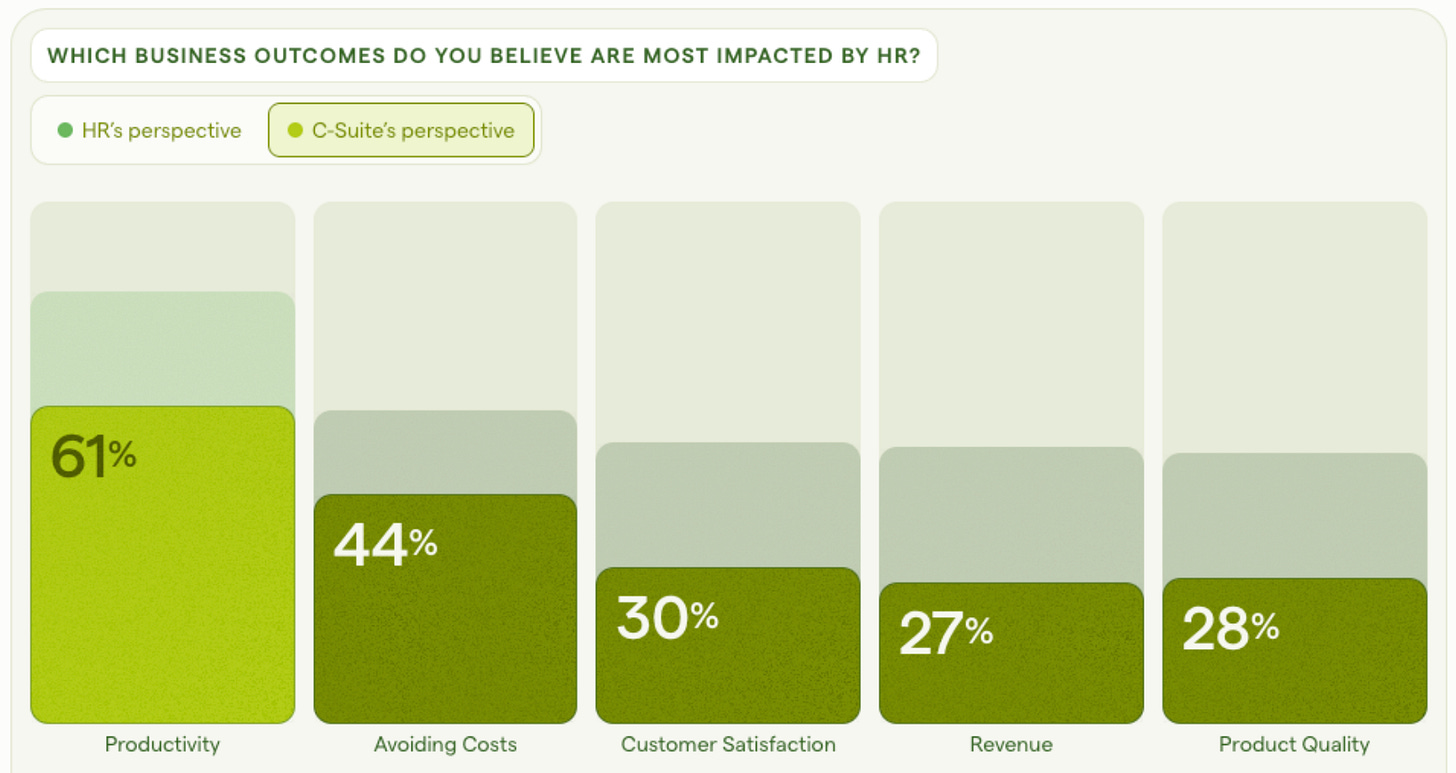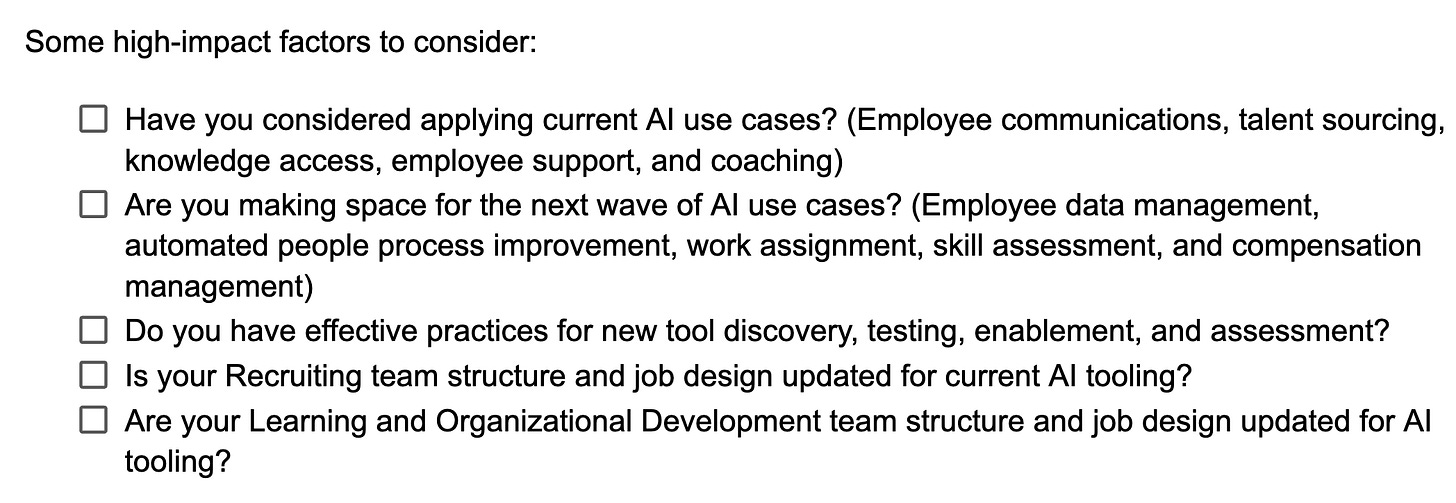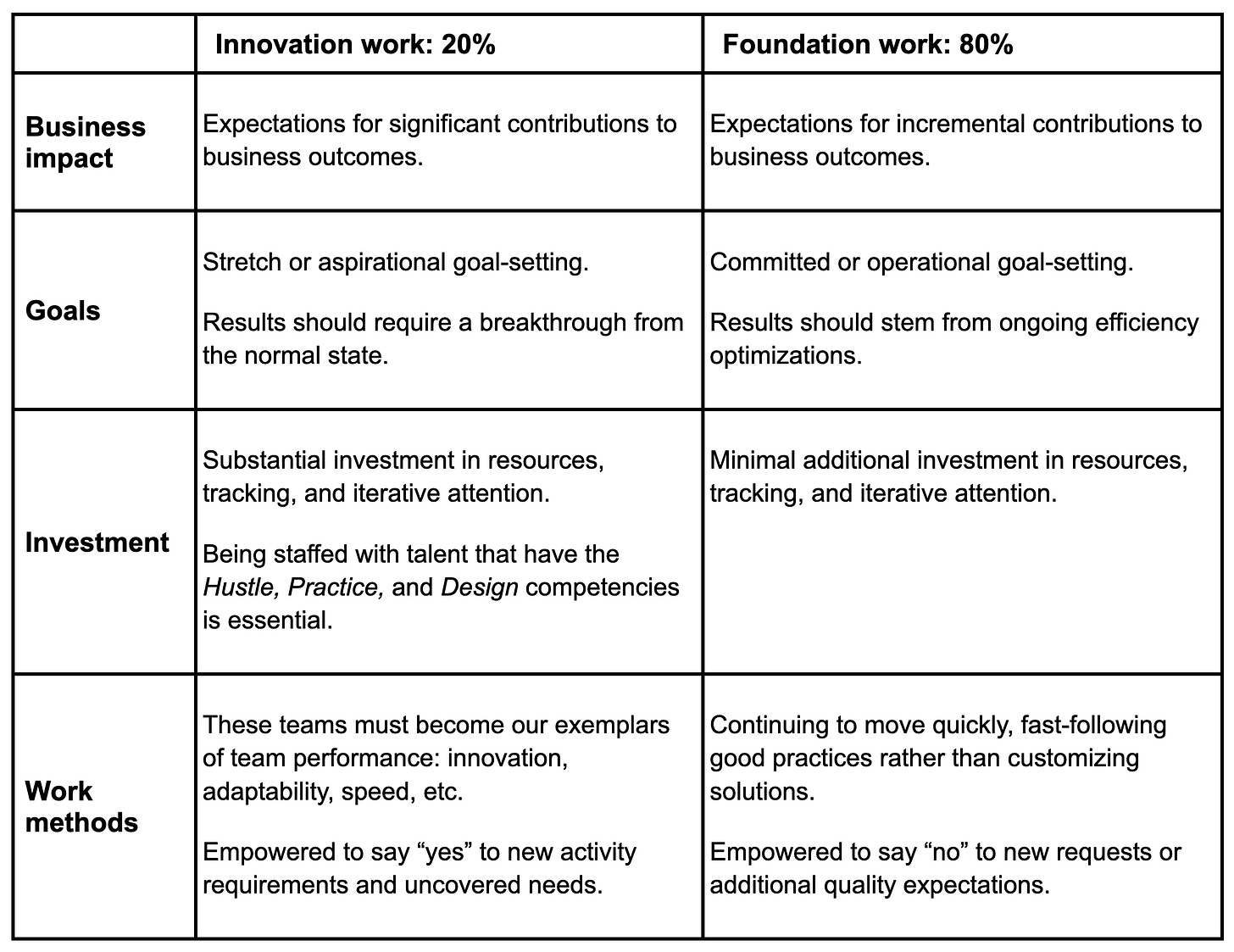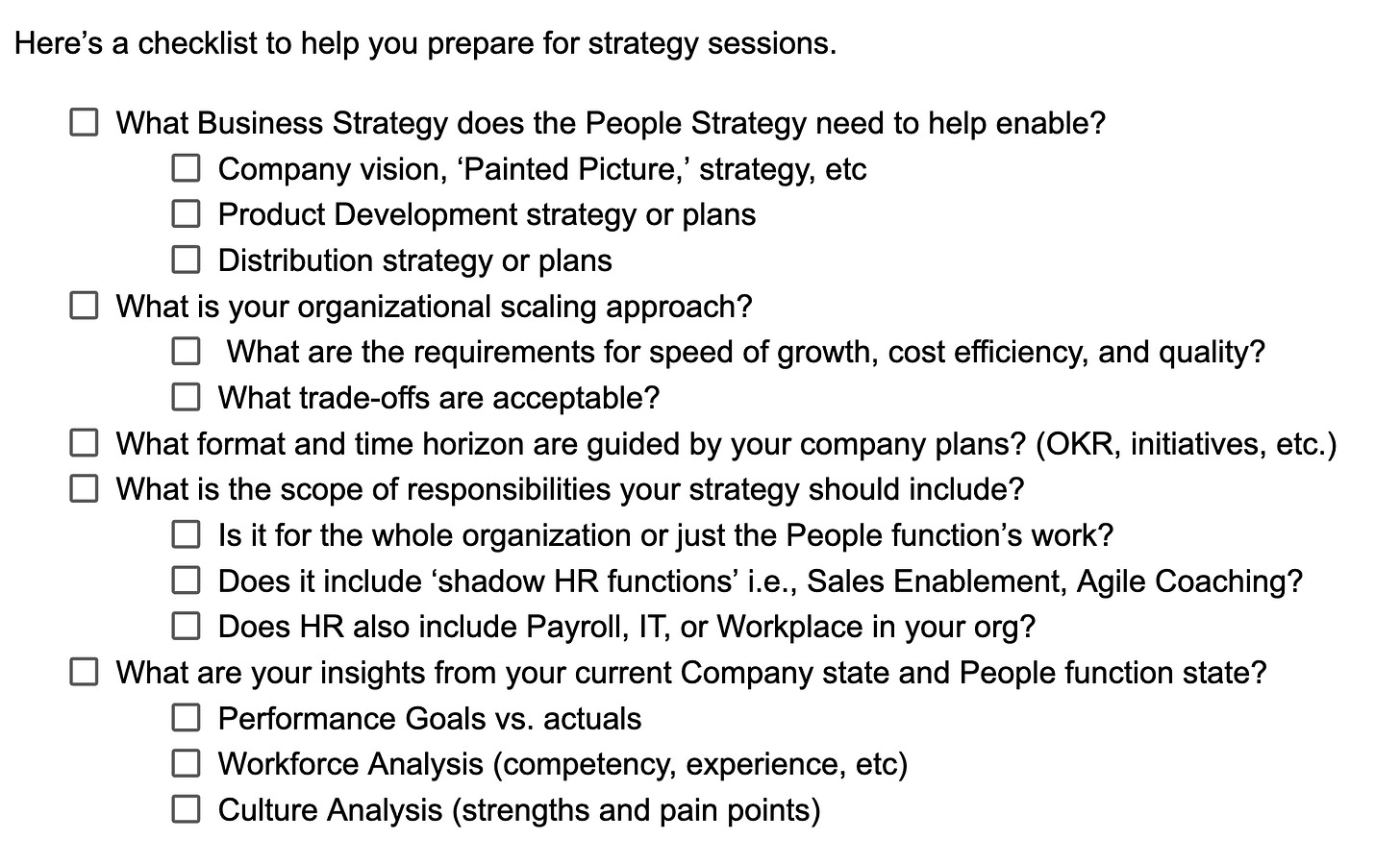Where HR falls short and what to do about it
HPP#1: How to develop a People Strategy that drives business success
Lattice's recent State of People Strategy 2024 is a challenging critique of the HR function’s ability to support scale-ups.
Key Finding #1: HR is struggling to demonstrate its impact
Key Finding #2: HR Leaders and the C-suite are disconnected
“While some HR teams are struggling to understand the impact of their work on key business outcomes, a vast majority of stakeholders outside of HR aren’t seeing it at all… Only 27% of respondents said their C-suite sees a connection between HR programs and revenue growth…(28%) sees a link to product/service quality and 30% to customer satisfaction.”
It is a difficult report card to receive. Over half of HR Leaders fell short of annual goals, with a twenty-five percentage point gap between how HR Leaders and the rest of the C-suite perceive HR’s business impact.
As with any critical feedback, there are multiple ways to react. The first is by framing the issue as one of perception rather than substance. The problem, as the report suggests, is
“(In HR) believing in the connection between their work and business outcomes and feeling confident in their ability to demonstrate that connection to other stakeholders.”
The article’s solutions follow suit, summarized as, We, HR Leaders, need more self-confidence in asserting our views of what’s essential. We need to use data and storytelling to gain alignment from our C-suite. Then, we can spend less time on executive alignment and more time working to drive business outcomes.
It is a comforting narrative, but that comfort should make us skeptical. It’s tempting to tell ourselves that we are right but misunderstood and that the solution is to double down on the confidence and communication skills that have helped us to get this far. But I think this is an instance of the “enemy is out there” trap.
“There is in each of us a propensity to find someone or something outside ourselves to blame when things go wrong… When we focus only on our position, we do not see how our own actions extend beyond the boundary of that position. When those actions have consequences that come back to hurt us, we misperceive these new problems as externally caused… This learning disability makes it almost impossible to detect the leverage we can use in here on problems that straddle the boundary between us and out there.”
There’s another way to take on tough feedback and a much more straightforward interpretation of the mess we’re in. What if executives, including HR Leaders, perceive that we aren't making an impact simply because People initiatives are not meaningfully increasing business outcomes? And that the disconnect between HR and other executives stems from us defending our agenda rather than inviting the rest of the C-Suite to help decide the tough trade-offs needed to move the needle?
A better way to create business impact in HR
In mid-2022, I led the People function at Miro as the organization reached one and a half thousand employees with hundreds of millions in revenue. The SaaS Crash had begun; it was wartime again. On the flight to our quarterly executive offsite, I finalized a report from our last employee engagement survey. It was a ten-page memo outlining strengths, pain points, the themes that would address hot topics, and structures for distributed implementation. It was a beautiful document: comprehensive, logical, and data-informed. My CEO’s response?
“None of these things are going to move the needle for us. What is the one underlying factor that all of these initiatives will target?”
I was crestfallen, but I also knew he was right. Targeting too many metrics across employee experience, learning, teams, operations, brand, quality, etc., and running initiatives deployed across the length of a scaled HR team would get the same OK results as before. “Peanut buttering” would not significantly impact the business. And this problem wasn’t just in engagement planning. I’d consistently multiplied our HR and recruiting agendas as we scaled since I joined in 2019.
Solving as many needs as possible, in line with practice from great scale-ups, had been my mantra. It helped to 10x our headcount in 3 years, as revenue expanded significantly faster. The approach worked well during zero-to-one growth, rapidly establishing global systems where there were few. When you’re “giving out Cokes in the desert,” the impact is clear. As the organization scaled and matured, this mantra no longer fit. Moving the needle for the business would now require breaking through established behaviors and systems. I needed better ways to pick points of change, to concentrate resources on them, and to help this investment yield significant results. I needed a People strategy.
Since leaving the executive team, I’ve tried to process this lesson and have worked with several HR Leaders on a better way to create business impact and alignment. When I was in the hot seat, I mistakenly thought I didn't need a high-level strategy, just operational rigor and good practice. I now realize I was limited in my capacity to think strategically while tending to the parallel explosions of grand scale (COVID, BLM, hyper-growth, Ukraine) and everyday scale (international expansion, VP hiring, tech stack changes, under-resourced teams). Below is the framework I wish I’d found four years ago. I hope it helps some of you who are riding that precious explosion today.
Make the most important thing the most important thing
Most HR Leaders have comprehensive operational plans outlined in documents structured to show alignment with high-level organizational goals. These plans help People team members know which of their activities to prioritize, give them specific measures to work against, and help them feel connected to company goals. As goals cascade through the teams, plans encompass most of the work in the function. We don’t significantly differentiate the level of ambition, investment, and ongoing attention across the breadth of these plans. We don’t concentrate enough resources to earn outsized benefits from winning strategies. Peanut buttering our investment across priorities creates priorities in name only.
The advantage of this practice is it doesn’t require taking any risks. We aren’t investing in anything specific. In fact, we’re following all the industry practices. As there aren’t enough resources and attention to fully invest in everything, any shortfalls can be excused by the breadth of parallel work and the lack of resources for any specific initiative. But this safe path also leads to the impact and alignment mess that we are in, so a different approach is needed.
If we want outsized impact from a few areas, we need to make the most important things the most important things. This means
selecting focuses where investment and attention have the best chance of impacting business outcomes,
investing in them through big goals, talent, and team operations,
adding design and management attention to help iterate and increase the chance of success,
deprioritizing investment and opting for incremental efficiency gains outside the focus.
What are the most important things?
Strategy is a guide for determining the most important things. Michael Porter, the godfather of corporate strategy, said,
“The essence of strategy is choosing what not to do. Without tradeoffs, there would be no need for choice... more of one thing necessitates less of another."
A good strategy must make choices, prioritize, and then inform cascading choices and prioritization throughout the function. Chosen areas must correlate highly with business success (measured by outcomes like productivity, product quality, cost, revenue, customer satisfaction, etc). They also need to be few in number, clear, and debatable. For scale-ups, I propose four focuses to create a People strategy.
This set might only seem controversial once we note the tradeoffs in selecting these focuses. The questions target specific outcomes: speed of teams, differentiation of recruiting, employee motivation and alignment, and increasing people operations efficiency. They don’t focus on employee satisfaction, experience, cost, capability, compliance, retention, brand, inclusion, or other vital factors. These should still be part of tracking and effort but not prioritized for our strategies focus as they aren’t as closely linked to medium-term business success in scaling tech firms. “More of one thing necessitates less of another.” You might disagree with the selection and find another set that better links to business impact in your organization, but you will still have to trade off against the rest. Here’s my view on why these four are critical for HR to impact the business's success.
1. How will you help teams across the company move faster/better?
Reed Hoffman described the hyperspeed scaling of start-ups “as a marathon of sprints.” The speed - and the speed of change - is incomparable to anything in industry. You need to build a lot, in parallel and right now. If you do, we’ll see if it works, and you win the chance to build even more. If you don’t, then thanks for playing. And maybe this game ain’t for you.
Successful start-ups all start fast. Good ones sustain the pace until they hit Dunbar’s Number of 150 people, where social group dynamics break and they need to systematize much more. Here, even they start to slow. At first, change is barely noticeable because they are moving so fast, but over time, sand in the gears of decision-making and communication begins to show, and the sense of momentum drops. By 500 employees, process friction, coordination costs, and enterprise maturity can quarter the speed of the earlier days. And by thousands, only the generational start-ups are still in top gear. Once momentum is lost, it is tough to get back. Executive teams should treat organizational speed as the most precious commodity, and People Leaders should ensure that they do no harm before they do good.
“Teams” are the focus instead of “individuals” because team performance is so sensitive to process quality within and around teams. Most start-ups are now team-focused in goal setting, design, and implementation. “Moving faster/better” is a proxy for team effectiveness. “Team Speed” is the most straightforward to understand and action, but other aspects that capture the essence of team effectiveness are also workable. Aligning on a choice gives a north star for your People team, a lens to learn from high and low team performance and a yardstick for iterating initiatives.
Your answer to “How will you help teams across the company move faster/better?” is your Organizational Agility strategy.
2. How will you differentiate to compete for the talent you need?
No one needs convincing that companies benefit from great talent. This consensus frames our challenge. The top half of start-ups are trying to get the top 10% of start-up talent. The market is inherently fierce, and you must pick your competitive strategy. The most significant factor, just how fast your business is growing (in revenue, users, funding, headcount, etc), is already your company’s biggest focus. But the locations you are competing in, what specific great talent you’re competing for, how much money and organizational focus you’ll spend fighting for it, your remote/in-person working model, and what significant intangibles you can bring to the fight are all open variables to play with.
Competition means you are not alone. Other good and great start-ups are dialing in their variables also. If you’re a 7 and they are an 8, they will win, unless you saved the point to spend on a more impactful area. But the best competition is not to compete. Blue Ocean Strategy suggests
“Competing in overcrowded industries is no way to sustain high performance. The real opportunity is to create blue oceans of uncontested market space.”
Before COVID, fully remote start-ups (like Elastic and Gitlab) deployed this effectively. There were few opportunities for skilled software developers in regional Switzerland, Kentucky, or three hours outside San Francisco. Similarly, ten years ago, the first US scale-up entrants into Poland, Ukraine, and Russia chose dynamics where their product (USD tech jobs) was strongly competed for by some of the most brilliant engineers in the world. These blue oceans seem obvious now, but they weren’t then. Now, it could just as likely be an online community adjacent to your product as an immigration opportunity from a challenging location. If you can find a blue ocean, invest in it and don’t compete. Otherwise, you must recognize and exploit your combined strengths against other good scale-ups.
Your answer to “How will you differentiate to compete for the talent you need?” is your Talent Competition strategy.
3. How will you build a culture that motivates and aligns employees?
“Culture Amp believes in the importance of putting culture first. Companies that share this belief (which we call culture first companies) recognize that if you take care of your people and your culture, then the customer experience and profits will take care of themselves… in our experience working with over 6,500 companies, we have found six key elements that successful culture first companies have in common. Transparency, open communication, inclusivity, accountability, values-based decision-making, leading by example.”
These are all fine factors that I would like to see in my employer, but do they drive business outcomes? Culture Amp’s annual conference featured a panel on “The business outcome of putting culture first,” with prominent examples of organizations that successfully prioritized the Culture First principles. The profiled companies included WeWork (‘47 Billion to bankruptcy’), Casper (acquired by PE as losses spiraled), and Patreon (‘Mismanagement thwarts a Pandemic star’). I don’t mean any slight against these firms or suggest these culture leaders weren’t delivering a great agenda in line with the six characteristics above. The example indicates that focusing on these factors is insufficient for driving business success. Ben Horowitz said it best ten years ago.
“The world is full of bankrupt companies with world-class cultures. Culture does not make a company. So, why bother with culture at all?
It matters to the extent that it can help you (build a 10x better product, win the market)…
As your company grows, culture can help you preserve your key values, make your company a better place to work, and help it perform better in the future.”
So, what cultural factors are most closely linked to business impact? A culture’s flavor is shaped by selecting between focuses like customers, efficiency, innovation, quality, impact, compliance, collaboration, empowerment, well-being, and more. The strength of the culture is determined by the degree to which its talent and interpersonal processes represent this focus. There are many viable, strong flavors, but those that most correlate with impact all contain high employee “motivation” and “alignment”.
Motivation is the commitment, energy, and creativity individuals bring to their work. Motivated employees make new things happen; demotivated ones, at best, keep things going.
Alignment is the degree to which individuals direct their work towards common goals and how they weigh these goals above their individual interests. Highly aligned companies put more shots on goal and can pivot when external circumstances change. Poorly aligned ones find their efforts dissipated across the many motivations of internal or external politics.
Motivation and alignment can form a positive flywheel, which we see most easily in quality early-stage start-ups. Start-up talent is self-selected for motivation and is easily screened for alignment by founders. The shared and mission-based sense of success drives intrinsic motivation. Small group social dynamics mean the whole team feels seen, creating powerful aligning forces. Team members who are not aligned are easily recognized and parted with, reinforcing the shared norms of the continuing group. The flywheel creates a powerful cultural force with the sense that we are running fast, together.
We need to build this positive cycle at each growth stage. At first, this is just the founding team’s personal characteristics and working styles. With scale, it includes shared practices and rituals that shape group dynamics. With further scale, it systematizes into processes, symbols, and rules that guide choices and behaviors for the many. The practices that meant so much to a group of 50 might be stale or not deliverable to a group of 500.
Your answer to “How will you build a culture that motivates and aligns employees?” is your Culture Engagement strategy.
4. How will the People team deliver these strategies with increasing efficiency as you scale?
Getting clear and invested in your Organizational Agility, Talent Competition, and Culture Engagement strategies is half the battle. Then, you must determine how to deliver the big bets that drive them. I think of a hierarchy of delivery for People teams:
Hustle: Being able to deliver
+Practice: Being able to deliver in line with good practice
++Design: Being able to deliver customized practice that yields outsized impact
If your teams aren’t producing, it doesn’t matter if you have best practices or great user discovery. If you deliver quickly and in line with industry practices, you are already at a competitive standard. But for the business impact we seek, we will need all this, customized to the organization's unique needs, and iterated until successful.
Agile is the least bad way to build new things that actually work, at scale. I’ve led agile HR teams at Salesforce and Miro, and too often, I’ve added #3 before securing #2, resulting in deep inefficiency. Design without delivery is a daydream. Delivery without design is a nightmare. But agile, loosely defined, is the only way I’ve seen #1, #2, and #3 come together. Whatever approach you choose, you will need to dial in your talent, team structures, design methodology, tracking, and iterative attention just to deliver the first three strategies.
Doing so with “increasing efficiency as you scale” seems either obvious or near impossible, largely dependent on whether you’ve run an HR function. Recruiting headcount grows close to linearly with organizational growth. Shifting from generalists to specialists across the department brings scale but adds coordination costs and loss of direct engagement that can quickly eat efficiency gains. Part of the answer is to ensure we are building our priority people teams with the speed, talent quality, and motivated alignment we are trying to bring to the rest of the organization.
The other element is transformative technology. Until last year, the rule in HRIS followed Horowitz’s guidance that there are no silver bullets, only lead ones. With generative AI, that might have changed. The best teams will be highly competent in selecting, deploying, and coaching around these tools and will be far leaner.
Your answer to “How will the People team deliver these strategies with increasing efficiency as you scale?” is your Operational Delivery strategy.
How do you make things important?
Now that we’ve selected the most important things, we need to make them important by concentrating ambition, resources, and attention on them. This concentration requires an antidote to the “peanut buttering” approach that has spread resources evenly on as big an agenda as possible. The antidote is the 80/20 rule.
“The Pareto principle (also known as the 80/20 rule) is a phenomenon that states that roughly 80% of outcomes come from 20% of causes… The goal is not to minimize the amount of effort, but to focus your effort on a specific portion of work to create a bigger impact.”
Good strategy helps us apply the 80/20 rule to divide our agenda into “Innovation” and “Foundation” categories and to concentrate our investment on potential winners. Making tradeoffs is emotionally tricky work. Saying “yes” to investing in an area requires a vulnerability that you might fail. Saying “no” requires the vulnerability of rejection. A good strategy helps depersonalize these decisions and makes this challenging work easier.
Some Innovation Work will create an outsized impact as intended, and others will fail. Close tracking and leader participation in the discovery and testing phases will bend the curve to the positive. Nonetheless, if leaders take broad accountability when we miss, they can require that lessons are learned to improve future cycles. The winners will have a transformative impact, showing the People team and broader culture that change is possible. Recognition for teams should be similarly outsized when they are successful. Both accountability and recognition ensure that the most important things stay the most important things.
Where to from here?
Are you ready for this? Aligning an executive team on a People strategy and shaping investment around it is an advanced practice. We can use this piece's Operational Delivery competency model to assess our planning maturity.
Hustle: Making operational plans in a timely and detailed way.
+Practice: Plans reflect good practice for peers.
++Design: Plans reflect strategy, with concentrated investment in breakthroughs.
If you haven’t locked in #1 or# 2, you can likely make efficient gains there. If you are already up to standard, you are ready for #3.
A central theme of this piece is that “focus is a trade-off.” I hope the investment in reading it pays off in real breakthroughs for your organization. If I can be helpful in this work, please contact me at aj@ajosephson.com for advisory or speaking inquiries. Thank you for reading! I look forward to your thoughts on this piece and ideas for what Hard People Problems are most important to solve.










